Numerical Simulation to Investigate the Effect of Adding a Fixed Blade to a Magnus Wind Turbine
Abstract
:1. Introduction
- −
- designing and creating a model of a wind turbine with fixed blade configurations;
- −
- determination of the moment of forces acting on a movable wind wheel;
- −
- analysis of the energy efficiency of the installation;
- −
- obtaining a flow pattern and pressure distribution of a three-bladed wind turbine.
2. Methodology
2.1. Creation of a Three-Dimensional Sample of a Wind Turbine with Three Blades
2.2. A System of Equations Describing the Flow of a Liquid in a Cartesian Coordinate System
2.3. The Realisable K-Turbulence Model
2.4. Computational Domain and Configuration
2.5. Mesh Configurations
3. Results and Discussion
4. Conclusions
- In the course of numerical studies, a three-dimensional sample of a wind turbine with three blades was created. The sample of a wind turbine consists of combined blades designed in the form of fixed blades and cylinders, a central shaft on which the working power elements are fixed, and a mast on which the main shaft is fixed. Mathematical models with different positions of the fixed blade were created (0°, 15°, 30°, 45°, and 60°), with further study of their influence on the hydrodynamic features and parameters of the entire installation.
- A line of the dependence of the moment of forces acting on a movable wind turbine with three blades on the velocity of the incoming flow was constructed. For a three-bladed wind turbine, the dependence of the influence of the rotation frequency on the value of the power coefficient Cp was obtained. The wind speed value was determined to correspond to a certain value of Cp. The developed wind turbine with three combined blades has a power coefficient of 0.28. Adding a fixed blade increases the efficiency of the wind turbine by 35–40% when compared with the results of other authors.
- When the fixed blade was positioned at angles of 0° and π/6, the effect on the distribution patterns of the velocity vector around a rotating wind wheel with three blades was studied. When the fixed blade was positioned at π/6, and at maximum rotational speeds, a flow disturbance was observed due to increased resistance. As a result, there is a decrease in the lifting force of the blades, which subsequently leads to a reduction in efficiency. Based on this, the favourable angle of the fixed blade is an angle of 0 degrees for both two-bladed and three-bladed wind turbines. The pressure distribution patterns around a rotating wind wheel with a fixed blade were obtained at 0 and 30 degrees. Based on the pressure distribution results, it is determined that when the fixed blade is located at π/6, the matrix layer is separated due to the braking of the wind wheel and an unfavourable pressure gradient. As a result, it was found that the location of the fixed blade at an angle of 0 degrees for the entire wind wheel is favourable for obtaining the optimal aerodynamic performance of all wind turbines.
Author Contributions
Funding
Data Availability Statement
Conflicts of Interest
References
- Moussa, M.O. Experimental and numerical performances analysis of a small three-blade wind turbine. Energy 2020, 203, 117807. [Google Scholar] [CrossRef]
- Ahmed, S.D.; Al-Ismail, F.S.; Shafiullah, M.; Al-Sulaiman, F.A.; El-Amin, I.M. Grid integration challenges of wind energy: A review. IEEE Access 2020, 8, 10857–10878. [Google Scholar] [CrossRef]
- IRENA—International Renewable Energy Agency. Available online: https://www.iaea.org/about/partnerships/irena (accessed on 1 July 2024).
- Elkodama, A.; Ismaiel, A.; Abdellatif, A.; Shaaban, S.; Yoshida, S.; Rushdi, M.A. Control methods for horizontal axis wind turbines (HAWT): State-of-the-art review. Energies 2023, 16, 6394. [Google Scholar] [CrossRef]
- Ghorani, M.M.; Karimi, B.; Mirghavami, S.M.; Saboohi, Z. A numerical study on the feasibility of electricity production using an optimised wind delivery system (Invelox) integrated with a Horizontal axis wind turbine (HAWT). Energy 2023, 268, 126643. [Google Scholar] [CrossRef]
- Mirsane, R.S.; Rahimi, M.; Torabi, F. Development of a novel analytical wake model behind HAWT by considering the nacelle effect. Energy Convers. Manag. 2024, 301, 118031. [Google Scholar] [CrossRef]
- Roga, S.; Bardhan, S.; Kumar, Y.; Dubey, S.K. Recent technology and challenges of wind energy generation: A review. Sustain. Energy Technol. Assess. 2022, 52, 102239. [Google Scholar] [CrossRef]
- Sharma, D.; Goyal, R. Methodologies to improve the performance of vertical axis wind turbine: A review on stall formation and mitigation. Sustain. Energy Technol. Assess. 2023, 60, 103561. [Google Scholar] [CrossRef]
- Li, G.; Li, Y.; Li, J.; Huang, H.; Huang, L. Research on dynamic characteristics of vertical axis wind turbine extended to the outside of buildings. Energy 2023, 272, 127182. [Google Scholar] [CrossRef]
- Al-Rawajfeh, M.A.; Gomaa, M.R. Comparison between horizontal and vertical axis wind turbine. Int. J. Appl. 2023, 12, 13–23. [Google Scholar] [CrossRef]
- Roy, S.; Das, B.; Biswas, A. A comprehensive review of the application of bio-inspired tubercles on the horizontal axis wind turbine blade. Int. J. Environ. Sci. Technol. 2023, 20, 4695–4722. [Google Scholar] [CrossRef]
- Li, M.; Dirik, Y.; Oterkus, E.; Oterkus, S. Shape sensing of NREL 5 MW offshore wind turbine blade using iFEM methodology. Ocean. Eng. 2023, 273, 114036. [Google Scholar] [CrossRef]
- Morina, R.; Akansu, Y.E. The Effect of Leading-Edge Wavy Shape on the Performance of Small-Scale HAWT Rotors. Energies 2023, 16, 6405. [Google Scholar] [CrossRef]
- Shankar, R.N.; Kumar, L.R.; Ramana, M.V. Design and fabrication of horizontal axis wind turbine. Int. J. Res. Anal. Rev. (IJRAR) 2019, 6, 545–549. [Google Scholar]
- Ranjan, R.; Pandey, R.; Singh, R.; Mohanty, S. Design and Modeling of Small Horizontal Axis Wind Turbine Blade for Low Wind Speed Characteristics. In International Conference on Machine Intelligence for Research & Innovations; Springer Nature: Singapore, 2023; pp. 271–279. [Google Scholar]
- Zareian, M.; Rasam, A.; Tari, P.H. A detached-eddy simulation study on assessing the impact of extreme wind conditions on load and wake characteristics of a horizontal-axis wind turbine. Energy 2024, 299, 131438. [Google Scholar] [CrossRef]
- Oukassou, K.; El Mouhsine, S.; El Hajjaji, A.; Kharbouch, B. Comparison of the power, lift and drag coefficients of wind turbine blade from aerodynamics characteristics of Naca0012 and Naca2412. Procedia Manuf. 2019, 32, 983–990. [Google Scholar] [CrossRef]
- Yan, C.; McDonald, J.G. Hyperbolic equivalent k-ϵ and k-ω turbulence models for moment-closures. J. Comput. Phys. 2023, 476, 111881. [Google Scholar] [CrossRef]
- De la Cruz-Ávila, M.; De León-Ruiz, J.E.; Carvajal-Mariscal, I.; Klapp, J. CFD Turbulence Models Assessment for the Cavitation Phenomenon in a Rectangular Profile Venturi Tube. Fluids 2024, 9, 71. [Google Scholar] [CrossRef]
- Rahman, M.M.; Karim, M.M.; Alim, M.A. Numerical investigation of unsteady flow past a circular cylinder using 2-D finite volume method. J. Nav. Archit. Mar. Eng. 2007, 4, 27–42. [Google Scholar] [CrossRef]
- Umar, D.A.; Yaw, C.T.; Koh, S.P.; Tiong, S.K.; Alkahtani, A.A.; Yusaf, T. Design and optimization of a small-scale horizontal axis wind turbine blade for energy harvesting at low wind profile areas. Energies 2022, 15, 3033. [Google Scholar] [CrossRef]
- Kriswanto; Setiawan, M.A.B.; Al-Janan, D.H.; Naryanto, R.F.; Roziqin, A.; Firmansyah, H.N.; Setiadi, R.; Darsono, F.B.; Setiyawan, A.; Jamari. Power Optimization of The Horizontal Axis Wind Turbine Capacity of 1 MW on Various Parameters of The Airfoil, an Angle of Attack, and a Pitch Angle. J. Adv. Res. Fluid Mech. Therm. Sci. 2023, 103, 141–156. [Google Scholar] [CrossRef]
- Kassa, B.Y.; Baheta, A.T.; Beyene, A. Current trends and innovations in enhancing the aerodynamic performance of small-scale, horizontal axis wind turbines: A review. ASME Open J. Eng. 2024, 3. [Google Scholar] [CrossRef]
- Marzuki, O.F.; Mohd Rafie, A.S.; Romli, F.I.; Ahmad, K.A. Magnus wind turbine: The effect of sandpaper surface roughness on cylinder blades. Acta Mech. 2018, 229, 71–85. [Google Scholar] [CrossRef]
- Ikezawa, Y.; Hasegawa, H.; Ishido, T.; Haniu, T.; Murakami, N. Three-dimensional flow field around a rotating cylinder with spiral fin for Magnus wind turbine. J. Flow Vis. Image Process. 2018, 25. [Google Scholar] [CrossRef]
- Demidova, G.L.; Anuchin, A.; Lukin, A.; Lukichev, D.; Rassõlkin, A.; Belahcen, A. Magnus wind turbine: Finite element analysis and control system. In Proceedings of the 2020 International Symposium on Power Electronics, Electrical Drives, Automation and Motion (SPEEDAM), Sorrento, Italy, 24–26 June 2020; IEEE: Piscataway, NJ, USA, 2020; pp. 59–64. [Google Scholar]
- Dyusembaeva, A.N.; Tleubergenova, A.Z.; Tanasheva, N.K.; Nussupbekov, B.R.; Bakhtybekova, A.R.; Kyzdarbekova, S.S. Numerical investigation of the flow around a rotating cylinder with a plate under the subcritical regime of the Reynolds number. Int. J. Green Energy 2024, 21, 973–987. [Google Scholar] [CrossRef]
- Tanasheva, N.; Tleubergenova, A.; Dyusembaeva, A.; Satybaldin, A.; Mussenova, E.; Bakhtybekova, A.; Shuyushbayeva, N.; Kyzdarbekova, S.; Suleimenova, S.; Tussypbayeva, A. Determination of the aerodynamic characteristics of a wind power plant with a vertical axis of rotation. East. Eur. J. Enterp. Technol. 2023, 122, 36. [Google Scholar] [CrossRef]
- Siddiqui, M.S.; Khalid, M.H.; Badar, A.W.; Saeed, M.; Asim, T. Parametric analysis using CFD to study the impact of Geometric and numerical modeling on the performance of a small-scale horizontal axis wind turbine. Energies 2022, 15, 505. [Google Scholar] [CrossRef]
- Regodeseves, P.G.; Morros, C.S. Unsteady numerical investigation of the full geometry of a horizontal axis wind turbine: Flow through the rotor and wake. Energy 2020, 202, 117674. [Google Scholar] [CrossRef]
- Heinz, S.; Mokhtarpoor, R.; Stoellinger, M. Theory-based Reynolds-averaged Navier–Stokes equations with large eddy simulation capability for separated turbulent flow simulations. Phys. Fluids 2020, 32. [Google Scholar] [CrossRef]
- Liu, M.; Wang, X. Three-dimensional wind field construction and wind turbine siting in an urban environment. Fluids 2020, 5, 137. [Google Scholar] [CrossRef]
- Tanasheva, N.K.; Bakhtybekova, A.R.; Shuyushbayeva, N.N.; Tussupbekova, A.K.; Tleubergenova, A.Z. Calculation of the aerodynamic characteristics of a wind-power plant with blades in the form of rotating cylinders. Tech. Phys. Lett. 2022, 48, 51–54. [Google Scholar] [CrossRef]
- Sørensen, J.N. General Momentum Theory for Horizontal Axis Wind Turbines; Springer: New York, NY, USA, 2016; Volume 4. [Google Scholar]
- Okulov, V.L.; Van Kuik, G.A. The Betz–Joukowsky limit: On the contribution to rotor aerodynamics by the British, German and Russian scientific schools. Wind Energy 2012, 15, 335–344. [Google Scholar] [CrossRef]
- Richmond-Navarro, G.; Calderón-Munoz, W.R.; LeBoeuf, R.; Castillo, P. A Magnus wind turbine power model based on direct solutions using the Blade Element Momentum Theory and symbolic regression. IEEE Trans. Sustain. Energy 2016, 8, 425–430. [Google Scholar] [CrossRef]
- Khadir, L.; Mrad, H. Numerical investigation of aerodynamic performance of Darrieus wind turbine based on the magnus effect. Int. J. Multiphysics 2015, 9, 383–396. [Google Scholar] [CrossRef]
- Tleubergenova, A.Z.; Tanasheva, N.K.; Shaimerdenova, K.M.; Kassymov, S.S.; Bakhtybekova, A.R.; Shuyushbayeva, N.N.; Uzbergenova, S.Z.; Ranova, G.A. Mathematical modeling of the aerodynamic coefficients of a sail blade. Adv. Aerodyn. 2023, 5, 14. [Google Scholar] [CrossRef]
- Alrowwad, I.; Wang, X.; Zhou, N. Numerical modelling and simulation analysis of wind blades: A critical review. Clean Energy 2024, 8, 261–279. [Google Scholar] [CrossRef]
- Bai, X.; Ji, C.; Grant, P.; Phillips, N.; Oza, U.; Avital, E.J.; Williams, J.J. Turbulent flow simulation of a single-blade Magnus rotor. Adv. Aerodyn. 2021, 3, 19. [Google Scholar] [CrossRef]
- Zhao, M. A review of recent studies on the control of vortex-induced vibration of circular cylinders. Ocean. Eng. 2023, 285, 115389. [Google Scholar] [CrossRef]
- Ma, Y.; Rashidi, M.M.; Yang, Z.G. Numerical simulation of flow past a square cylinder with a circular bar upstream and a splitter plate downstream. J. Hydrodyn. 2019, 31, 949–964. [Google Scholar] [CrossRef]
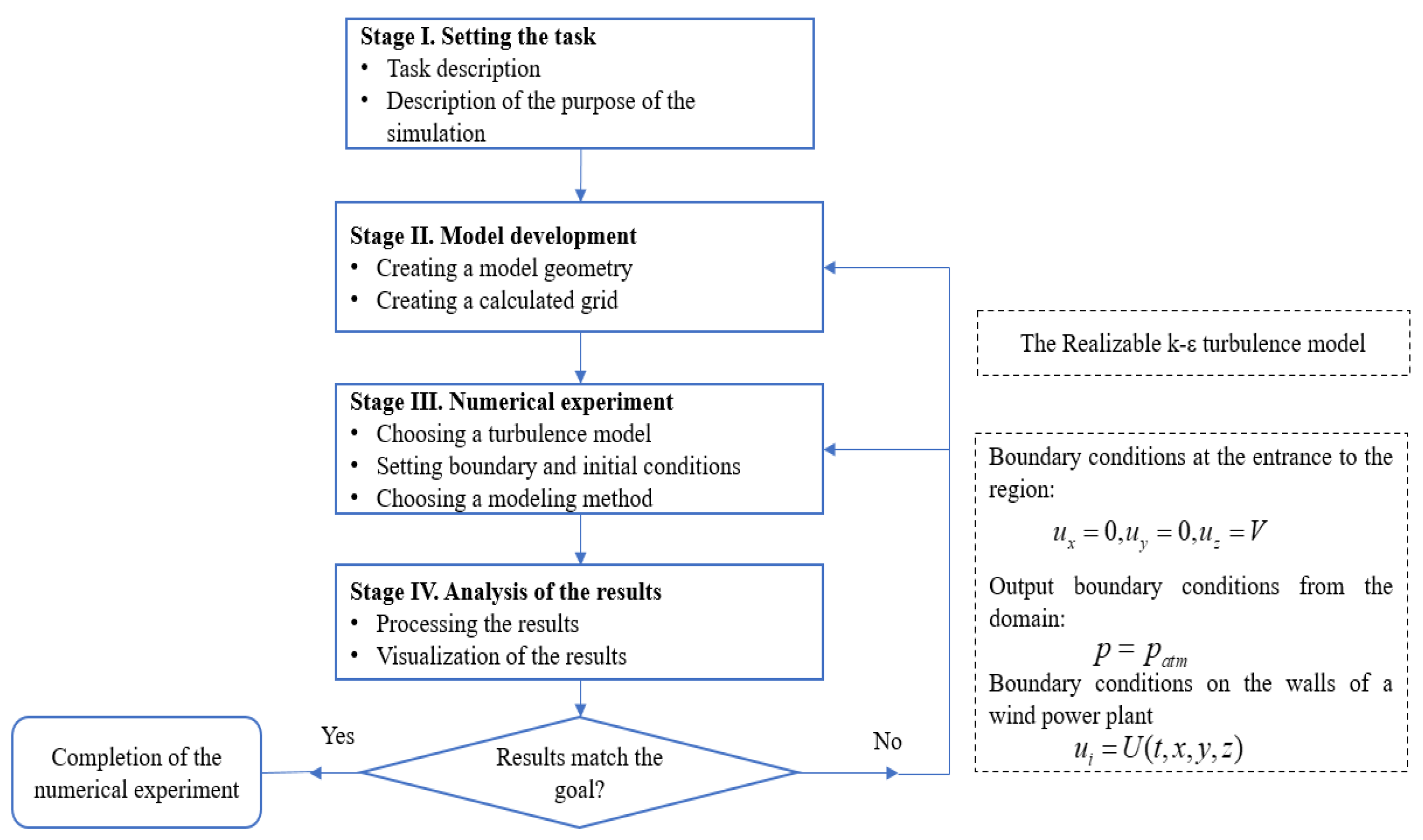
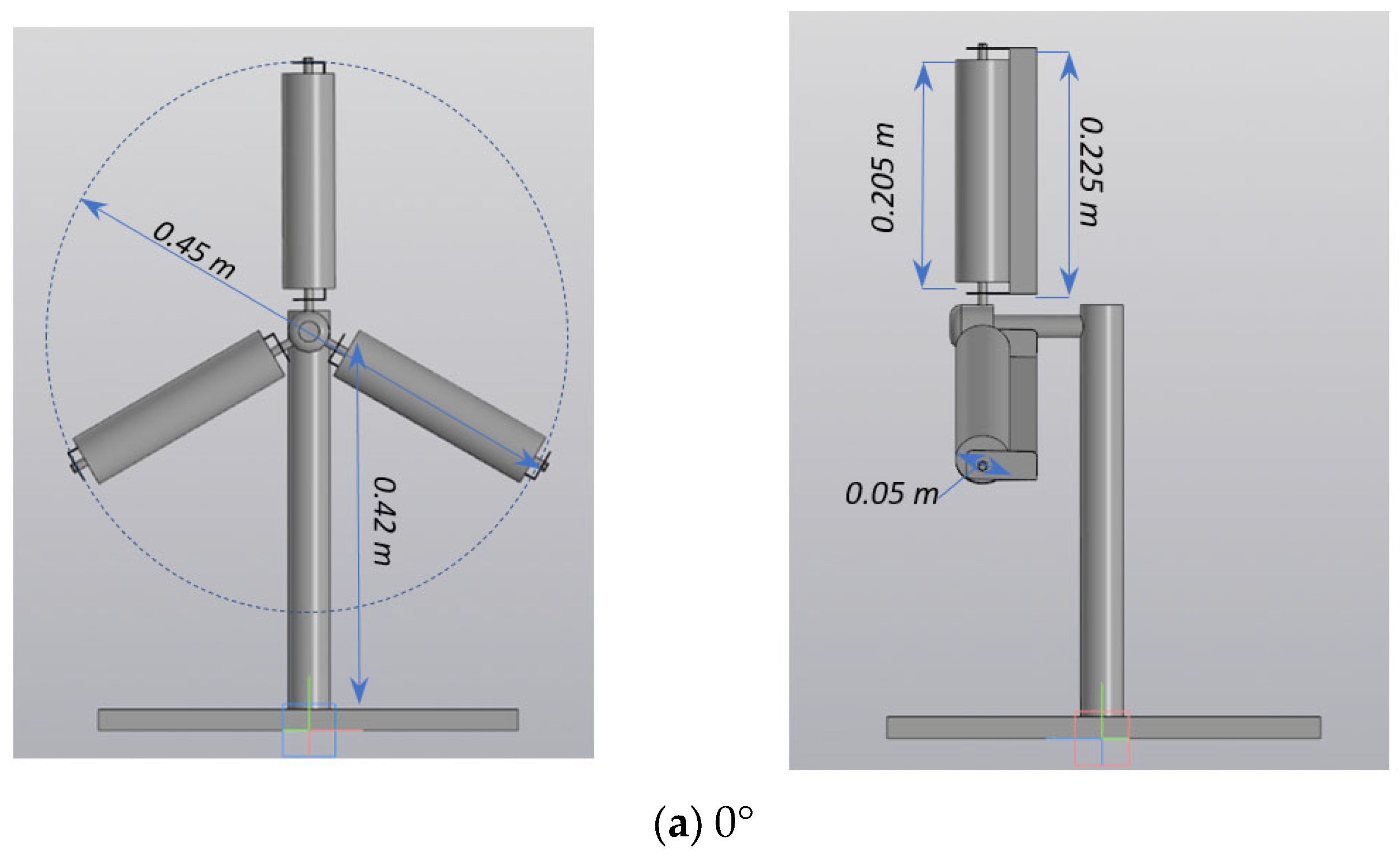
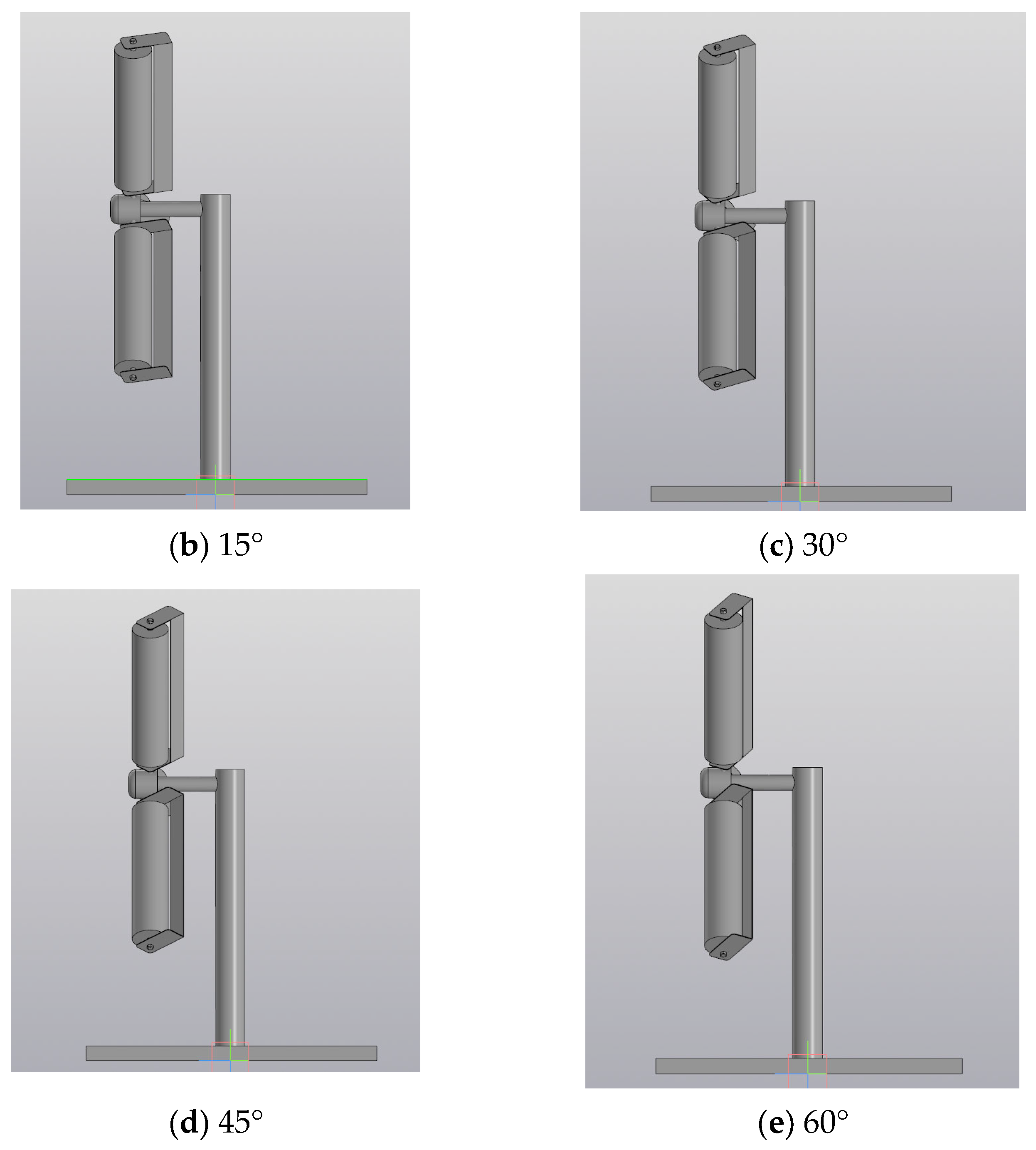




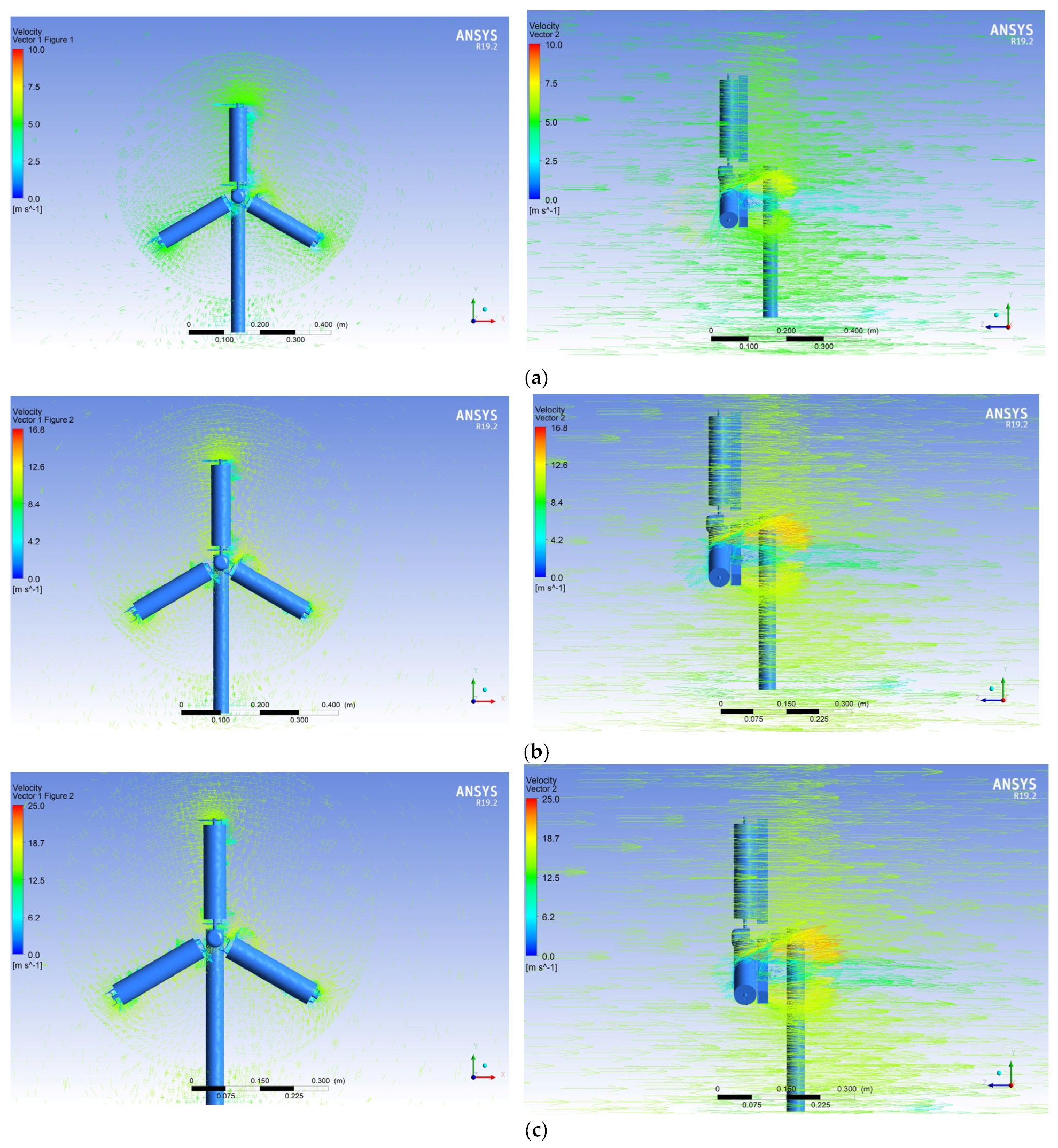
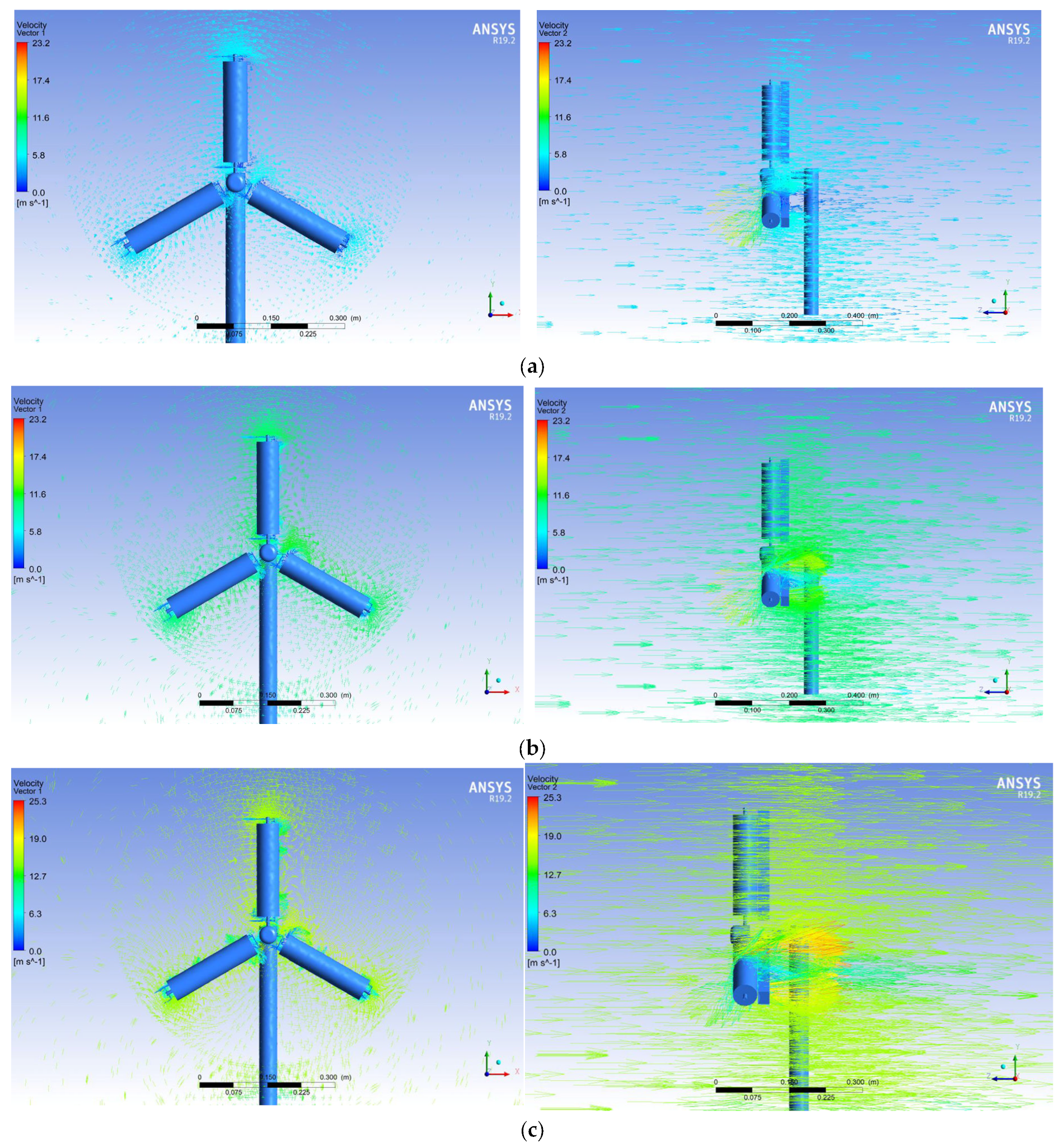

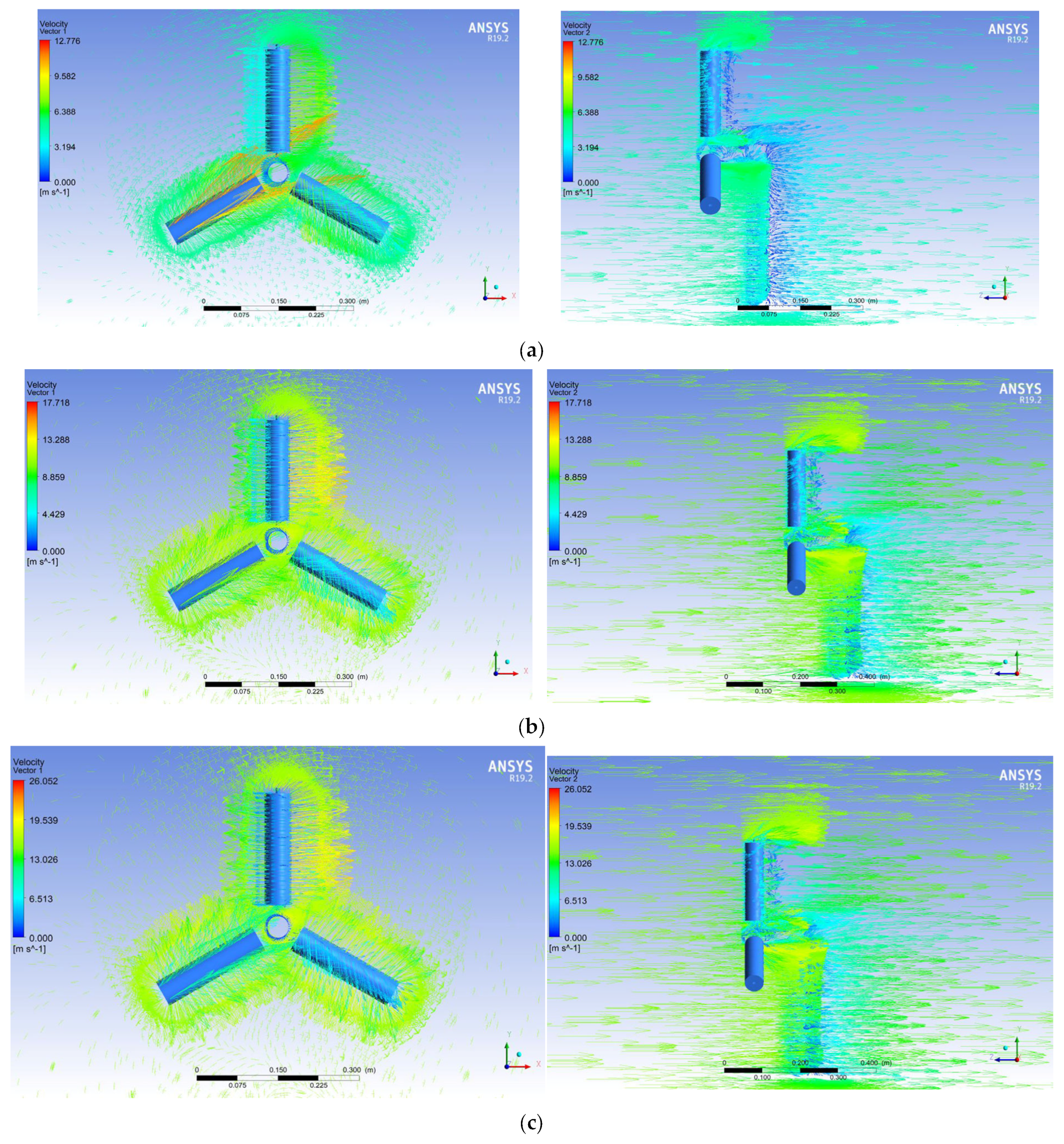

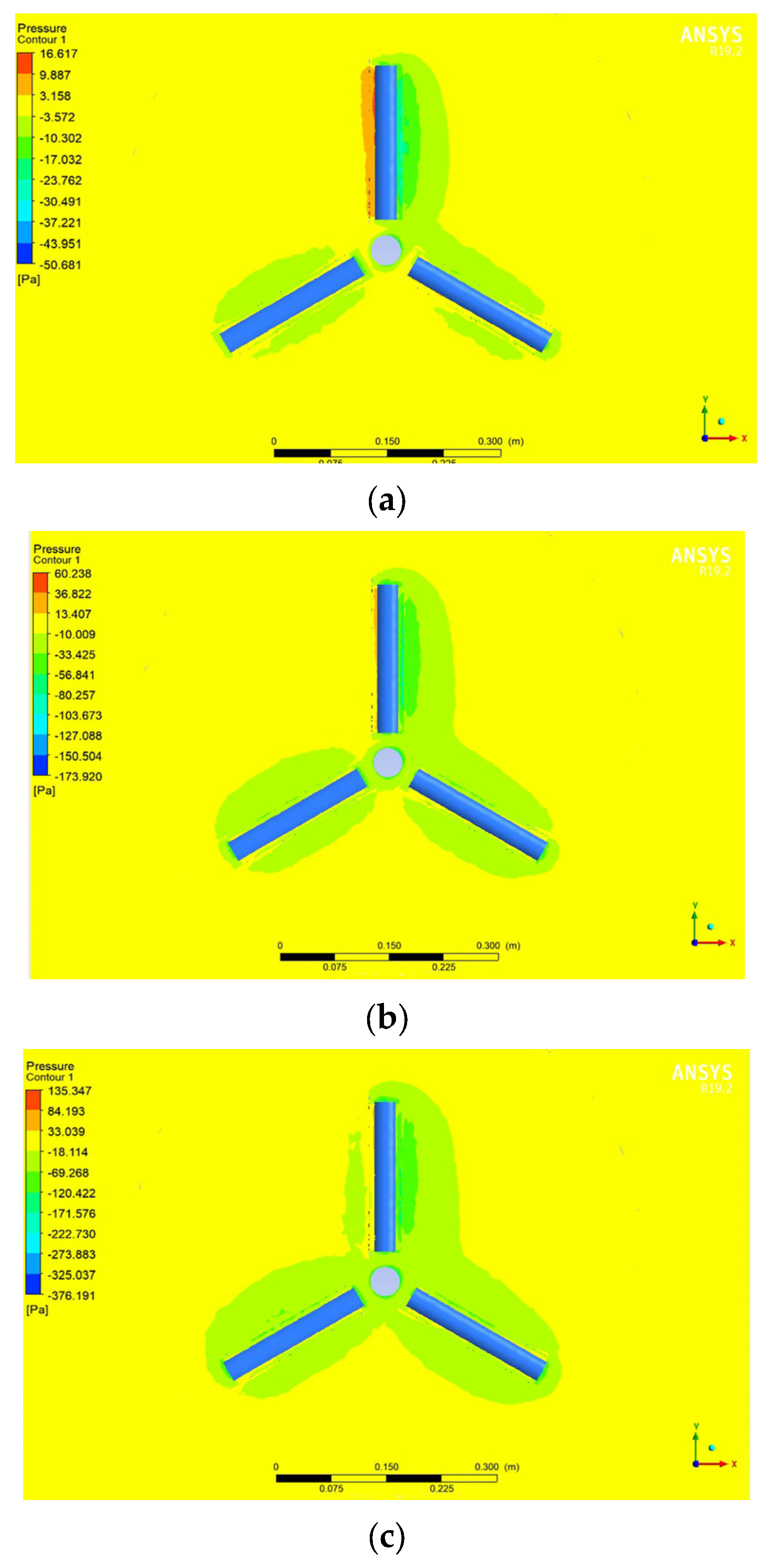
| Parameter | Values |
|---|---|
| Type of air | Incompressible |
| Type of flow | Isothermal |
| Gas density | 1.1691 kg/m3 |
| Viscosity of the gas | 1.84 × 10−5 kg/ms−1 |
| Viscous Regime | Turbulent |
| Reynolds-Averaged Turbulence | Realisable k-epsilon |
| Solvers: Time-Step | 0.00425 s |
| Maximum Inner Iterations | 30 |
| Name | Number of Cells | Power Coefficient Cp |
|---|---|---|
| Mesh 1 | 568,410 | 0.274 |
| Mesh 2 | 785,452 | 0.280 |
| Mesh 3 | 890,120 | 0.281 |
Disclaimer/Publisher’s Note: The statements, opinions and data contained in all publications are solely those of the individual author(s) and contributor(s) and not of MDPI and/or the editor(s). MDPI and/or the editor(s) disclaim responsibility for any injury to people or property resulting from any ideas, methods, instructions or products referred to in the content. |
© 2024 by the authors. Licensee MDPI, Basel, Switzerland. This article is an open access article distributed under the terms and conditions of the Creative Commons Attribution (CC BY) license (https://creativecommons.org/licenses/by/4.0/).
Share and Cite
Dyusembaeva, A.; Tanasheva, N.; Tussypbayeva, A.; Bakhtybekova, A.; Kutumova, Z.; Kyzdarbekova, S.; Mukhamedrakhim, A. Numerical Simulation to Investigate the Effect of Adding a Fixed Blade to a Magnus Wind Turbine. Energies 2024, 17, 4054. https://doi.org/10.3390/en17164054
Dyusembaeva A, Tanasheva N, Tussypbayeva A, Bakhtybekova A, Kutumova Z, Kyzdarbekova S, Mukhamedrakhim A. Numerical Simulation to Investigate the Effect of Adding a Fixed Blade to a Magnus Wind Turbine. Energies. 2024; 17(16):4054. https://doi.org/10.3390/en17164054
Chicago/Turabian StyleDyusembaeva, Ainura, Nazgul Tanasheva, Ardak Tussypbayeva, Asem Bakhtybekova, Zhibek Kutumova, Sholpan Kyzdarbekova, and Almat Mukhamedrakhim. 2024. "Numerical Simulation to Investigate the Effect of Adding a Fixed Blade to a Magnus Wind Turbine" Energies 17, no. 16: 4054. https://doi.org/10.3390/en17164054






